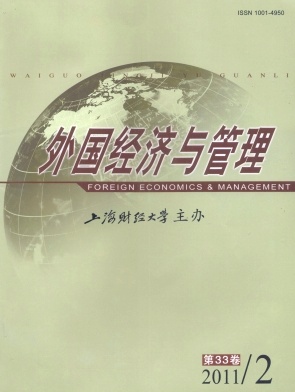企业知识产权策略研究现状探析与未来展望
外国经济与管理 2011 年 第 33 卷第 02 期, 页码:17 - 25
摘要
参考文献
摘要
在当今知识经济背景下,知识产权日益成为企业竞争优势的重要来源,因此亟待企业通过实施配套策略来加以管理。本文对关于企业知识产权策略的已有研究文献进行了梳理,分析了企业知识产权策略这一概念的演化过程,归纳总结了企业知识产权策略的前因变量、结果变量和调节变量,并阐述了它们之间的关系,最后针对现有研究的不足,从知识产权战略性开发等方面对未来相关研究进行了展望。
[1]Reitzig,M.Strategic management of intellectual property[J].MIT Sloan Management Review,2004,45(3):35-40.
[2]Rivette,K G,and Kline D.Discovering newvalue inintellectual property[J].Harvard Business Review,2000,(1/2):54-66.
[3]Alexy,O,Criscuolo,P,and Salter,A.Does IP strategy have to cripple open innovation?[J].MIT Sloan Management Review,2009,51(1):70-77.
[4]Smith,M,and Hansen,F.Managingintellectual property:Astrategic point of view[J].Journal of Intellectual Capital,2002,3(4):366-374.
[5]Pitkethly,R.Intellectual property strategy in Japanese and UK companies:Patent licensing decisions and learning opportunities[J].Research Policy,2001,30(3):425-442.
[6]Granstrand,O.The economics and management of intellectual property:Towards intellectual capitalism[M].London:Edward El-gar,2000:209-234.
[7]Reitzig,M.Howexecutives can enhance IP strategy and performance[J].MIT Sloan Management Review,2007,49(1):37-43.
[8]Norcia,V.Intellectual property and the commercialization of research development[J].Science and Engineering Ethics,2005,11(2):203-219.
[9]Davis,J L,and Harrison,S S.董事会里的爱迪生:智力资产获利方法[M].(江林等译).北京:机械工业出版社,2003.
[10]Arahi,H.The facts behind Japan’s technology explosion[J].Managing Intellectual Property,2000,5(1):19-21.
[11]Mansfield,E.Patents andinnovation:An empirical study[J].Management Science,1986,32(2):173-184.
[12]Yang,D.Culture matters to multinationals’intellectual property businesses[J].Journal of World Business,2005,40(2):281-301.
[13]Samson,D.Intellectual property strategy and business strategy connection throughinnovation strategy[R].Working Paper No.08/05,ISSN1 447-1 795.
[14]Motohashi,K.Licensing or not licensing:Empirical analysis on strategic use of patent in Japanese firms[R].RIETI DiscussionSeries,2008,06-E-021:1-15.
[15]Scellato,G.Patents,firmsize and financial constraints:An empirical analysis for a panel of Italian manufacturing firms[J].Cam-bridge Journal of Economics,2007,31(1):55-76.
[16]Schneider,J E.Intellectual property:The driving force for growth and funding[J].Journal of Commercial Biotechnology,2002,8(4):320-324.
[17]Bekkers,R.Intellectual property rights,strategic technology agreements and market structure:The case of GSM[J].ResearchPolicy,2002,31(7):1 141-1 161.
[18]Lichtenthaler,U,and Ernst,H.Technologylicensing strategies:Theinteraction of process and content characteristics[J].Strate-gic Organization,2010,7(2):183-221.
[19]Teece,DJ,Pisano,G,and Shuen,A.Dynamic capabilities and strategic management[J].Strategic Management Journal,1997,18(7):509-533.
[20]Lumpkin,G T,and Dess,G G.Clarifying the entrepreneurial orientation construct andlinkingit to performance[J].Academy ofManagement Review,1996,21(1):135-172.
[2]Rivette,K G,and Kline D.Discovering newvalue inintellectual property[J].Harvard Business Review,2000,(1/2):54-66.
[3]Alexy,O,Criscuolo,P,and Salter,A.Does IP strategy have to cripple open innovation?[J].MIT Sloan Management Review,2009,51(1):70-77.
[4]Smith,M,and Hansen,F.Managingintellectual property:Astrategic point of view[J].Journal of Intellectual Capital,2002,3(4):366-374.
[5]Pitkethly,R.Intellectual property strategy in Japanese and UK companies:Patent licensing decisions and learning opportunities[J].Research Policy,2001,30(3):425-442.
[6]Granstrand,O.The economics and management of intellectual property:Towards intellectual capitalism[M].London:Edward El-gar,2000:209-234.
[7]Reitzig,M.Howexecutives can enhance IP strategy and performance[J].MIT Sloan Management Review,2007,49(1):37-43.
[8]Norcia,V.Intellectual property and the commercialization of research development[J].Science and Engineering Ethics,2005,11(2):203-219.
[9]Davis,J L,and Harrison,S S.董事会里的爱迪生:智力资产获利方法[M].(江林等译).北京:机械工业出版社,2003.
[10]Arahi,H.The facts behind Japan’s technology explosion[J].Managing Intellectual Property,2000,5(1):19-21.
[11]Mansfield,E.Patents andinnovation:An empirical study[J].Management Science,1986,32(2):173-184.
[12]Yang,D.Culture matters to multinationals’intellectual property businesses[J].Journal of World Business,2005,40(2):281-301.
[13]Samson,D.Intellectual property strategy and business strategy connection throughinnovation strategy[R].Working Paper No.08/05,ISSN1 447-1 795.
[14]Motohashi,K.Licensing or not licensing:Empirical analysis on strategic use of patent in Japanese firms[R].RIETI DiscussionSeries,2008,06-E-021:1-15.
[15]Scellato,G.Patents,firmsize and financial constraints:An empirical analysis for a panel of Italian manufacturing firms[J].Cam-bridge Journal of Economics,2007,31(1):55-76.
[16]Schneider,J E.Intellectual property:The driving force for growth and funding[J].Journal of Commercial Biotechnology,2002,8(4):320-324.
[17]Bekkers,R.Intellectual property rights,strategic technology agreements and market structure:The case of GSM[J].ResearchPolicy,2002,31(7):1 141-1 161.
[18]Lichtenthaler,U,and Ernst,H.Technologylicensing strategies:Theinteraction of process and content characteristics[J].Strate-gic Organization,2010,7(2):183-221.
[19]Teece,DJ,Pisano,G,and Shuen,A.Dynamic capabilities and strategic management[J].Strategic Management Journal,1997,18(7):509-533.
[20]Lumpkin,G T,and Dess,G G.Clarifying the entrepreneurial orientation construct andlinkingit to performance[J].Academy ofManagement Review,1996,21(1):135-172.
引用本文
薛元昊, 王重鸣. 企业知识产权策略研究现状探析与未来展望[J]. 外国经济与管理, 2011, 33(2): 17–25.
导出参考文献,格式为:
上一篇:国外绿色创业研究现状评介





 5756
5756  757
757

